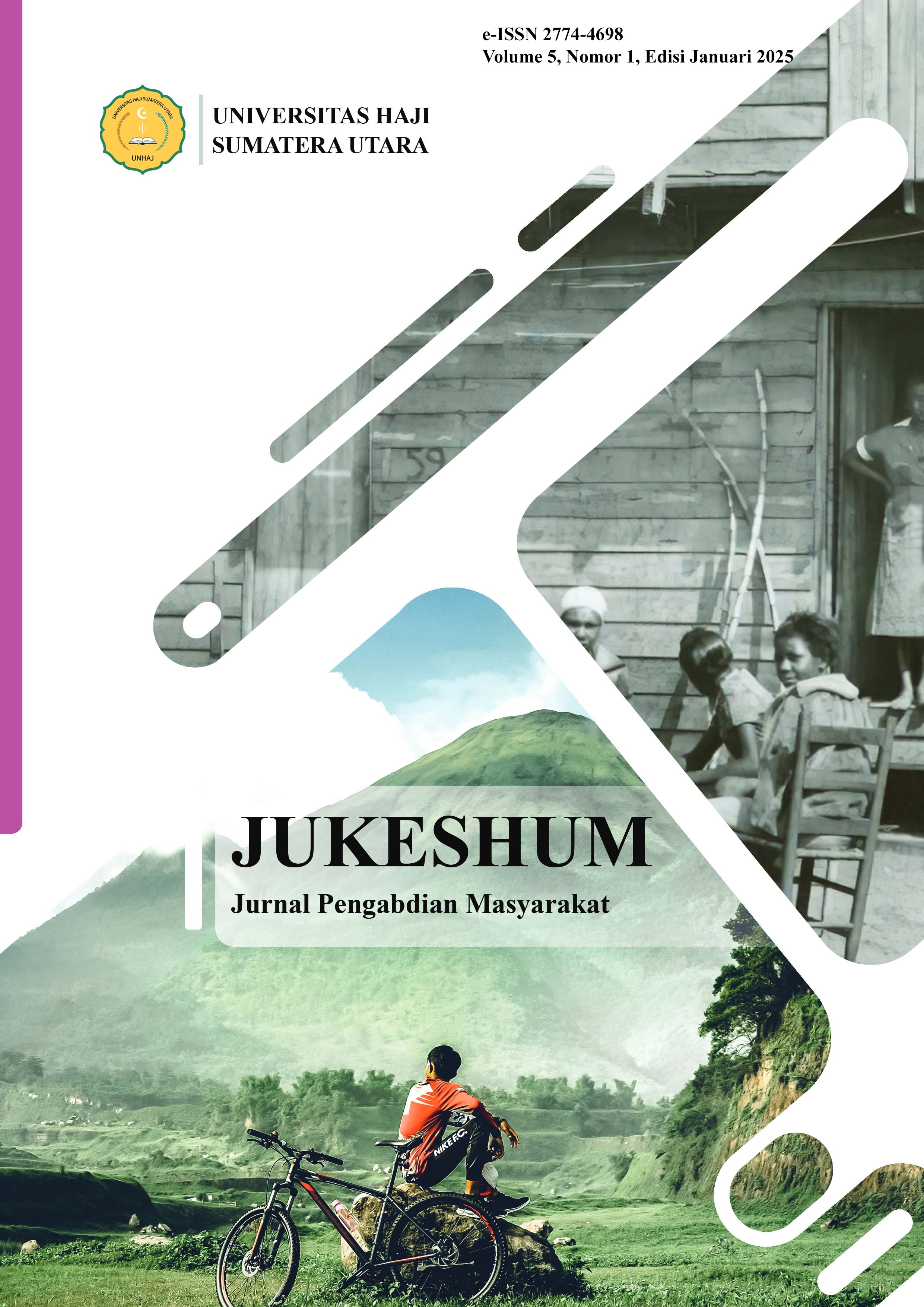Utilization Of Natural Materials As Universal Natural Food Colors Red Yellow Green In The Community Of Sidomulyo Village Biru-Biru District
Pemanfaatan Bahan Alam Sebagai Pewarna Pangan Alami Universal Merah Kuning Hijau Pada Masyarakat Desa Sidomulyo Kecamatan Biru-Biru
DOI:
https://doi.org/10.51771/jukeshum.v5i2.1012Keywords:
Utilization of Natural Ingredients, Universal Natural Dyes, Red Yellow GreenAbstract
Food coloring is an additional ingredient used to produce food products so they are more attractive to consume. Synthetic food coloring comes from chemicals, can contain dangerous metals and/or benzene rings which have the potential to cause various diseases in humans. Meanwhile, natural dyes are obtained from natural ingredients so they are safer to use. The aim of this community service is to provide understanding to the public about the benefits of plants in the form of fruit, leaves and fruit skins that are no longer used as natural food coloring.
This community service (PkM) is carried out by socializing the use of fruit and/or fruit waste, fresh leaves which are commonly found in the community, such as dragon fruit peel as waste. Other ingredients used are turmeric rhizomes and bay leaves, suji leaves and pandan leaves. Socialization of making food coloring materials is carried out using electronic media such as videos. Meanwhile, the explanation of the material is carried out using the presentation and discussion method.
Based on the results of the implementation of this PkM, the people of Sidomulyo Village, Biru-Biru District, were very enthusiastic and eager to take part in this activity. The people of Sidomulyo Village can understand and comprehend the dangers of using synthetic dyes and understand the benefits of using natural dyes in food produced in the household. Then in the future, the results of this community service can be applied to products that can be marketed commercially to increase family income.
References
Adriani, A., & Zarwinda, I. (2019). Pendidikan Untuk Masyarakat Tentang Bahaya Pewarna Melalui Publikasi Hasil Analisis Kualitatif Pewarna Sintetis Dalam Saus. Jurnal Serambi Ilmu, 20(2), 217–237.
Fardani, R. A. (2023). Analisis Kandungan Pewarna Sintetis Pada Jajanan Pasar Di Kota Mataram Dengan Kromatografi Kertas. JSN : Jurnal Sains Natural, 1(1), 23–31. https://doi.org/10.35746/jsn.v1i1.289
Lingkungan, P., Limbah, P., Buah, K., Menjadi, N., Makanan, P. A., Komang, N., & Artiningsih, A. (2023). Environmental Management and Utilization Of Dragon Fruit Skin Waste To Become A Natural Food Coloring. Jurnal Agrifoodtech, 2(1), 2963–7422. https://jurnal2.untagsmg.ac.id/index.php/agrifoodtech
Marpaung, A. M. (2018). Potensi Pewarna Alami Lokal untuk Industri Pangan. Food Rev. Ind, 13.
Muhaimin, Yohana Chaerunisaa, A., Milanda, T., Timur Maisyarah, I., Lestari, U., Kusuma Dewi, M., Mardiana, L., & Erlianti, K. (2023). Sosialisasi Pemanfaatan Pewarna Alami Pada Pengolahan Kerupuk Lakar Di Umkm N&N Jatinangor. Communnity Development Journal, 4(5), 11147–11152.
Puspawani, I., & Riyani, N. (2021). Inovasi Produk Es Krim Dengan Pemanfaatan Limbah Kulit Buah Naga Merah dan Bunga Telang Sebagai Pewarna Alami. Prosiding HUBISINTEK, 370–374.
http://ojs.udb.ac.id/index.php/HUBISINTEK/article/view/1410
Puteri, F. D. (2020). Karakterisasi Dan Uji Intensitas Warna Kuning Pada Ekstrak Campuran Kunyit-Daun Salam Yang Berpotensi Sebagai Pewarna Pangan Universal. Jurnal Ilmiah Kesehatan Sandi Husada, 9(2), 860–864.
Rinawati, R., Sembiring, Z., Simanjuntak, W., & Rosa, E. (2021). Pembuatan Serbuk Pewarna Alami Dari Berbagai Tanaman Tropis Dengan Metode Oven Drying. Jurnal Pengabdian Kepada Masyarakat (JPKM) TABIKPUN, 2(2), 101–108. https://doi.org/10.23960/jpkmt.v2i2.20
Sari, P. I., Daulay, A. S., Ridwanto, R., & Munandar, H. (2024). Uji Intensitas Warna Kuning pada Campuran Sari Kunyit-Daun Salam dan Temulawak Daun Salam Sebangai Pewarna Pangan Universitas Muslim Nusantara Al-Washliyah , Indonesia Tempat dan Waktu Penelitian Penelitian dilakukan di Laboratorium Tepadu Fakultas Farmas. OBAT: Jurnal Riset Ilmu Farmasi dan Kesehatan, 2(3), 44–62.
Wiyono, W. M., Waluyo, B., & Anindito, T. (2024). Penyuluhan Hukum Tentang Perlindungan Konsumen Terhadap Tambahan Pewarna Makanan Di Desa Jetis Kecamatan Kemangkon Kabupaten Purbalingga. WIKUACITYA: Jurnal Pengabdian Kepada Masyarakat, 3(1), 82–89.
Downloads
Published
Issue
Section
License
Copyright (c) 2025 Anny Sartika Daulay, Ridwanto Ridwanto, Alistraja Dison Silalahi, Sri Wahyuni, Gabena Indrayani Dalimunthe

This work is licensed under a Creative Commons Attribution-ShareAlike 4.0 International License.
Hak Cipta dan Lisensi
Penulis yang mempublikasikan naskahnya melalui Jukeshum: Jurnal Pengabdian Masyarakat menyetujui beberapa hal berikut:
- Hak Cipta atas naskah-naskah karya ilmiah di dalam Jurnal ini dipegang oleh Penulis.
- Penulis menyerahkan hak saat pertama kali mempublikasi Naskah karya ilmiahnya dan secara bersamaan Penulis memberikan izin/lisensi dengan mengacu pada Creative Commons Attribution-ShareAlike 4.0 International License kepada pihak lain untuk menyebarkan karya ilmiahnya tersebut dengan tetap mencantumkan penghargaan bagi penulis dan Jukeshum: Jurnal Pengabdian Masyarakat sebagai media Publikasi pertama atas karya tersebut.
- Hal-hal yang berkaitan dengan non-eksklusivitas pendistribusian Jurnal yang menerbitkan karya ilmiah penulis dapat diperjanjikan secara terpisah (contoh: permintaan untuk menempatkan karya yang dimaksud pada perpustakaan suatu institusi atau menerbitkannya sebagai buku) dengan Penulis sebagai salah satu pihak perjanjian dan dengan penghargaan pada Jukeshum: Jurnal Pengabdian Masyarakat sebagai media publikasi pertama atas karya dimaksud.
- Penulis dapat dan diharapkan untuk mengumumkan karyanya secara online (misalnya pada Repositori atau pada laman Organisai/Institusinya) sejak sebelum dan selama proses pengumpulan naskah, sebab upaya tersebut dapat meningkatkan pertukaran citasi lebih awal dan dengan cakupan yang lebih luas.








